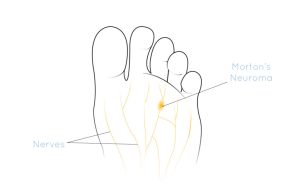Metatarsalgia
What is Metatarsalgia?
Metatarsalgia is a broad term used to describe pain in the ball of your foot that can be due to a many problems related to joints, tendons, ligaments or nerves. Metatarsalgia can be a very painful condition that limits walking and recreational activities as well as your choice of foot wear.
Causes of pain in ball of the foot & Metatarsalgia treatment:
Morton’s Neuroma:
Morton’s neuroma is a benign swelling and thickening of the nerve often affecting the ball of the 3rd and 4th toe causing a sharp shooting pain, burning and feeling of a lump.
Investigations usually include ultrasound to confirm size and location followed by injections or surgery if the guided injections fail.
Bursitis:
Bursitis is a swollen sack of bursa fluid that is naturally found between metatarsals. It often gets irritated and inflamed by tight fitting shoes, sports or thinning of the fat pad under the balls of the feet.
Joint Swelling:
Joint swelling often known as capsulitis or synovitis can be as a result of trauma, over use or systemic factor associated with disease.
After a detailed history we may request specialist investigations to diagnose the joint swelling, including X-rays, ultrasound and/or MRI followed by treatment with orthotics and injections.
Plantar Plate Tear:
Plantar plate tear is a ligament tear at the ball of the toe joint causing, swelling and a lump like feeling. If left untreated a plantar plate this can lead to floating and hammer toe deformity.
Specialised ultrasound or MRI Arthrogram is required to conform diagnosis, plantar plate tear often requires surgery if it is not treated immediately with splinting.
Hammer Toes:
Hammer toe can often cause pain in the ball of the foot due to the toes buckling.
Surgical straightening of the toes can be performed to correct the underlying cause.
Long Metatarsal:
A genetically long metatarsal can often cause forefoot imbalance and increased pressure resulting in joint pain and problems. Shortening of the metatarsal can resolve this problem.
Diagnosing Metatarsalgia:
It is important to accurately distinguish between the causes of metatarsalgia and accurately diagnose the underlying cause.
A combination of X-rays, Ultrasound and MRI may be used to diagnose metatarsalgia and the underlying problem. Early diagnosis and prevention can prevent surgical intervention.
Our consultant, Mr Kaser Nazir, is best suited to assist with an assessment and treatment plan.
Frequently asked questions
Metatarsalgia can be treated with orthotics to offload the area, sometimes an injection is necessary. Imaging can be requested to identify the problem. In some cases surgery is required to shorten a bone to help reduce pressure. The exact treatment will depend on the underlying cause. This is why it is important to see a specialist who can properly diagnose the cause and devise a treatment plan.
Metatarsalgia is pain under the balls of the feet. Most of the time it is developed from overloading of one of these joints
Orthotics and injections can help with metatarsalgia. Surgery may otherwise be suggested. If you see a podiatric specialist they will be able to assess you to discuss a treatment plan, they can also give you advice on how to prevent it from recurring.
Related Blogs
Thoughts and advice on foot health care from the Podogo team.


















































